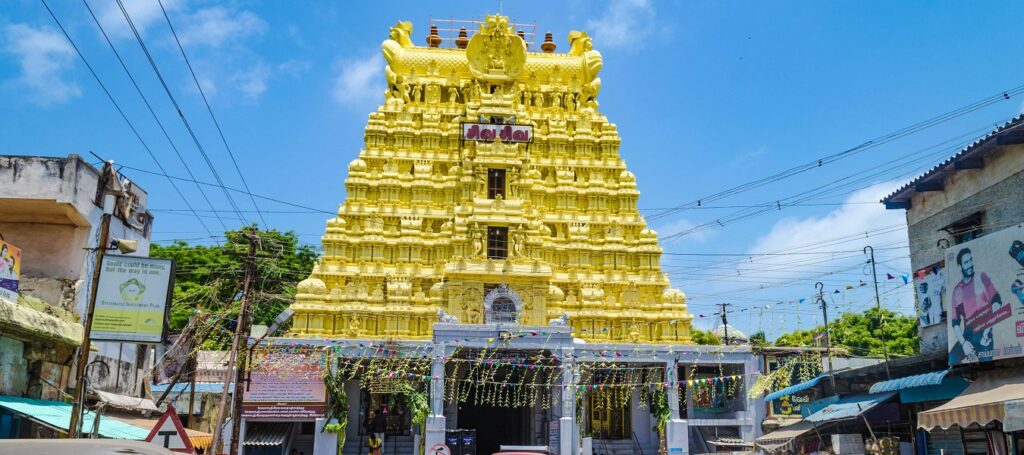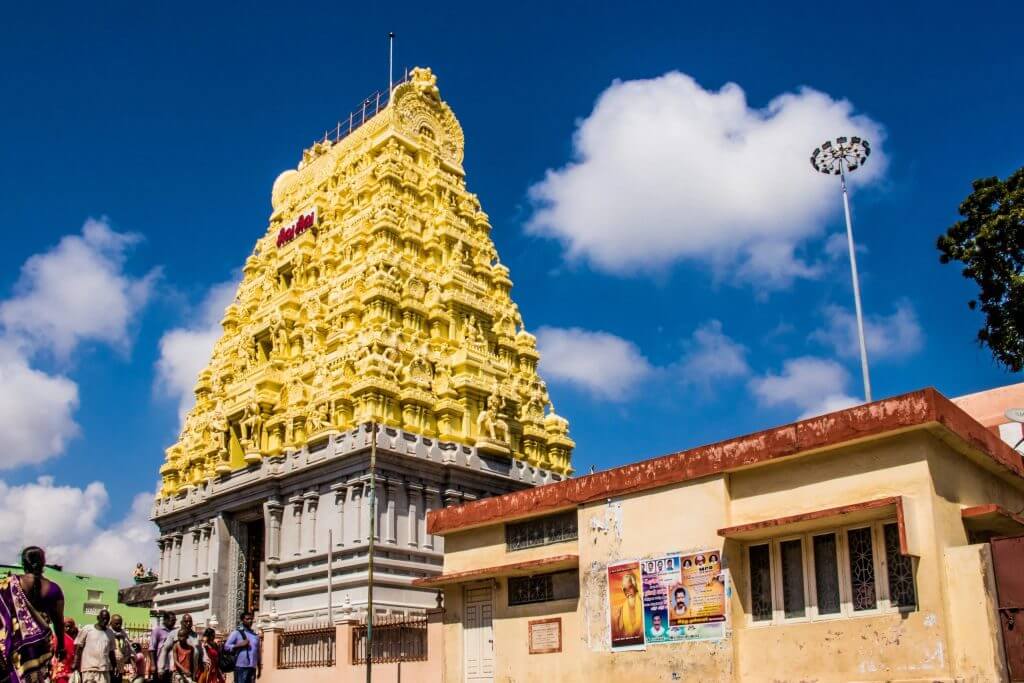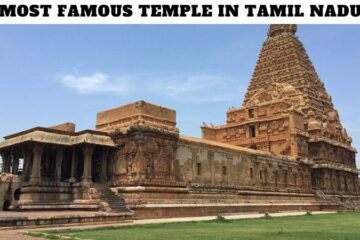
The Ramanathaswamy Temple Rameswaram is a Hindu temple dedicated to the god Shiva located on Rameswaram island in the state of Tamil Nadu, India. It is considered one of the holiest places in India and is one of the twelve Jyotirlinga temples, which represent the twelve manifestations of Shiva in Hindu mythology. The temple is also one of the 275 Paadal Petra Sthalams, where saint poets (Saivite saints), Appar, Sundarar and Tirugnana Sambandar, have glorified the temple with their songs.
Ramanathaswamy Temple Timing
The Ramanathaswamy Temple Rameswaram follows specific timings for visitors:
Morning: The temple opens for darshan (holy viewing) between 5:00 AM and 1:00 PM.
Evening: The temple reopens in the evening for darshan from 3:00 PM and remains open until 9:00 PM.
Arulmigu Ramanathaswamy Temple Rameswaram Deity
The primary deity of the Ramanathaswamy Temple is Lord Shiva, worshipped in the form of a Lingam. Here’s a breakdown of the specific Lingams associated with the temple’s legend:
Ramalingam: This Linga is believed to have been created by Sita from sand at the instruction of Lord Rama. It is considered the main deity in the temple’s sanctum sanctorum.
Vishvalingam: According to another account, Rama requested a Linga from Kashi (Varanasi) and Hanuman brought this specific Linga. Devotees offer prayers to this Vishvalingam first, following the order instructed by Rama himself.
Ramanathaswamy Temple Rameswaram Location
The Arulmigu Ramanathaswamy Temple is located in Rameswaram, an island town in the Pamban district of Tamil Nadu, India.
History of Ramanathaswamy Temple Rameswaram
The history of the Ramanathaswamy Temple Rameswaram is a fascinating blend of mythology and verifiable history. Here’s a breakdown of its historical timeline:
Ancient Origins and Mythology:
- Legend links the temple to Lord Rama, the protagonist of the epic Ramayana. It’s believed Rama worshipped a Shiva Linga (representation of Shiva) here before his battle with the demon king Ravana in Lanka.
- Some accounts say Goddess Sita even created a sand Linga in case Hanuman, Rama’s loyal monkey devotee, couldn’t bring one from the Himalayas.
Early Historical Developments:
- Although concrete evidence is limited, there might have been a temple structure as early as the 11th or 12th century, based on architectural styles.
- The Pandya Dynasty, ruling south India during the 12th century, is believed to have played a role in the temple’s initial construction.
Medieval Period and Royal Contributions:
- The 16th and 17th centuries saw significant development under the Sethupathi rulers.
- King Kizhavan Sethupathi or Raghunatha Kilavan is credited with authorizing the temple’s main construction.
- The magnificent corridors, a defining feature, were built by King Muthuramalinga Sethupathi. Notably, the third corridor is the longest in all Hindu temples of India.
- The Jaffna kingdom’s kings, particularly Jeyaveera Cinkaiariyan and Gunaveera Cinkaiariyan, also contributed by renovating the sanctum sanctorum.
Later Developments and Significance:
- The temple’s current form is believed to be from the 17th century.
- Over the centuries, the temple has been a revered pilgrimage site for Shaivites, Vaishnavites, and Smarthas alike.
- Even Swami Vivekananda, the renowned Hindu monk, is said to have visited the temple in the late 19th century.

Legend Associated with Ramanathaswamy Temple
The legend associated with the Arulmigu Ramanathaswamy Temple is deeply rooted in the epic Ramayana and revolves around Lord Rama, his wife Sita, and their quest to defeat the demon king Ravana. Here’s the core of the legend:
Seeking absolution: After defeating Ravana in Lanka and rescuing Sita, Rama felt the need to seek forgiveness for any sins he might have committed during the war, particularly the killing of Ravana, who was a Brahmin (considered a high caste in Hinduism).
Worshiping Shiva: Upon the advice of sages, Rama decided to worship Lord Shiva, the embodiment of forgiveness and destroyer of evil.
Two Lingams: The legend presents two variations on how the Shiva Linga for worship was obtained:
- Sita’s creation: In one version, Rama instructed his loyal monkey lieutenant Hanuman to bring a Linga from the Himalayas. Anticipating a delay, Sita fashioned a Linga out of sand for immediate worship. This Linga is said to be the Ramalingam, the main deity in the temple’s sanctum.
- Hanuman’s quest: Another account suggests Rama requested a Linga from Kashi (Varanasi). Hanuman successfully brought this Linga, known as the Vishvalingam.
Temple’s name: The name Rameswaram itself translates to “Lord Rama’s Ishwaram” (Ishwaram meaning “Lord”). This association with Rama further strengthens the temple’s legendary significance.
Architecture of Ramanathaswamy Temple
The Ramanathaswamy Temple is a magnificent example of Dravidian architecture, a style known for its towering gateways, intricate carvings, and spacious halls. Here’s a breakdown of its key architectural features:
Grand Entrance and Enclosure:
- High Compound Wall (Madil): Like many South Indian temples, the Ramanathaswamy Temple is encompassed by a high wall on all four sides, offering a sense of privacy and grandeur to the sacred space within.
Towering Gopurams:
- Eastern and Western Gopurams: The temple boasts two grand Gopurams (gateway towers) on the eastern and western sides. These pyramidal structures are a characteristic feature of Dravidian architecture and are often elaborately decorated with sculptures and mythological figures. The eastern gopuram is particularly noteworthy, reaching a height of 126 feet with nine tiers.
Extensive Corridors (Prakaras):
One of the Longest Corridors: Perhaps the most defining architectural aspect of the temple are its long corridors, stretching for over 4,000 feet. This is considered the longest corridor among all Hindu temples in India. These corridors are lined with intricately carved granite pillars, some mounted on raised platforms.
Unique Granite Pillars: The pillars themselves are a marvel of engineering. They are said to be made from granite brought in from elsewhere in Tamil Nadu, showcasing the planning and logistical prowess involved in the temple’s construction. An interesting feature is that the pillars, when viewed from a certain angle, appear to converge at a single point, creating an optical illusion.
Inner Halls and Shrines:
Multiple Mandapas: Inside the temple complex, you’ll find various halls (mandapas) leading to the sanctum sanctorum. These halls often serve as gathering places or house smaller shrines dedicated to other deities.
Sanctum Sanctorum: The innermost sanctum houses the two Shiva Lingas associated with the temple’s legend – the Ramalingam and the Vishvalingam.
Building Materials:
- The temple is primarily constructed from limestone and granite, materials known for their durability and ability to withstand the tropical climate.

Significance of Ramanathaswamy Temple Today
The Ramanathaswamy Temple holds immense significance even today, and for several reasons:
Religious Importance: It remains a revered pilgrimage site for Hindus, particularly Shaivites and Vaishnavites. As one of the 12 Jyotirlinga shrines dedicated to Shiva, it attracts devotees seeking blessings and spiritual growth.
Mythological Connection: The temple’s association with the Ramayana keeps it relevant for followers of Lord Rama. Pilgrims come to experience the place where Rama is believed to have worshipped.
Cultural and Historical Landmark: The temple’s architectural splendor and rich history make it a significant cultural landmark in India. It serves as a testament to the artistic heritage and religious devotion of past eras.
Symbol of Unity: The reverence for both Shiva and Rama at the temple transcends sectarian divides, promoting a sense of unity among Hindus.
Tourist Destination: The temple’s unique architecture and historical importance attract a large number of tourists, both domestic and international.
Here are some additional points highlighting its contemporary significance:
Spiritual Practices: Devotees continue the tradition of taking the holy ‘theertha snanam’ (sacred bath) in the 22 theerthams (natural springs) within the temple complex, believed to cleanse sins and bring blessings.
Temple rituals: The temple priests perform daily pujas (worship rituals) following traditions established centuries ago. Devotees can witness these rituals and participate in various offerings.
Economic Impact: The temple plays a significant role in the local economy, generating revenue through donations and tourism. It also provides employment opportunities for priests, guides, and shopkeepers in the surrounding area.
Best time to Visit Arulmigu Ramanathaswamy Temple Rameswaram
The best time to visit Ramanathaswamy Temple Rameswaram depends on what you prioritize during your visit. Here’s a breakdown of the pros and cons of different times to visit:
Pleasant Weather (November to February)
- Pros: This is the peak tourist season in Rameshwaram, with comfortable temperatures ranging from 20°C to 30°C (68°F to 86°F). It’s an ideal time for sightseeing and outdoor activities.
- Cons: The temple can be crowded, especially during festivals. Prices for accommodation and transportation may also be higher during this time.
Shoulder Months (March to April and October)
- Pros: These months offer a good balance of pleasant weather and fewer crowds compared to peak season. You’ll find good deals on accommodation and transportation during this shoulder season.
- Cons: The weather can be slightly warm, especially in April. There might be a chance of occasional showers in October.
Less Crowded (May to September)
- Pros: This is the least crowded time to visit the temple. You’ll get the best deals on hotels and flights.
- Cons: The weather can be quite hot and humid, with temperatures reaching up to 40°C (104°F). The monsoon season (July to September) can bring heavy rainfall, potentially disrupting travel plans.
Specific days to Consider:
- Early Mornings: The temple is generally less crowded early in the morning, around 4:00 AM to 6:30 AM. This is a good time for a peaceful visit and to witness the sunrise over the temple complex.
- Aarti timings: If you want to experience the temple’s special pujas (aarti), you can plan your visit around the aarti timings. These are usually held at specific times throughout the day.

How to Reach Ramanathaswamy Temple By Air, Train, And Road?
Reaching Ramanathaswamy Temple
While Ramanathaswamy Temple itself doesn’t have an airport, there are several ways to reach the temple by air, train, and road, depending on your preference and origin city. Here’s a breakdown of how to get there:
By Air: The nearest airport to Rameshwaram, where the temple is located, is Madurai Airport (IXM), at a distance of approximately 147.9 kilometers (92 miles). Several domestic airlines operate flights to Madurai from major cities in India, including:
- Chennai
- Mumbai
- Delhi
- Bangalore
- Hyderabad
Once you arrive at Madurai Airport, you can hire a taxi or take a bus to reach Rameshwaram. The journey by road typically takes 3-4 hours.
By Train: Rameshwaram is well-connected to major South Indian cities by rail. Rameshwaram Railway Station has five platforms and offers trains to destinations including:
- Coimbatore
- Trichy
- Madurai
- Thanjavur
- Chennai
You can find train schedules and book tickets online or at the railway station.
By Road: Rameshwaram is easily accessible by road from various South Indian cities and towns. Regular government and private buses connect Rameshwaram to places like:
- Madurai
- Kanyakumari
- Chennai
- Coimbatore
- Trichy
If you’re looking for a more personalized experience, you can also hire a taxi or car to get to Rameshwaram.
FAQs - Frequently Asked Questions about Ramanathaswamy Temple
Q. Where is the Ramanathaswamy Temple located?
A. The Ramanathaswamy Temple is situated in Rameswaram, an island town in the Pamban district of Tamil Nadu, India.
Q. How do I reach the Ramanathaswamy Temple?
A. Rameswaram is accessible by air, train, and road. The nearest airport is Madurai Airport (IXM), approximately 147.9 kilometers away. Trains connect Rameswaram to major South Indian cities. Regular buses and taxis also provide transportation options.
Q. What are the temple timings?
A. The temple is open for darshan (holy viewing) between 5:00 AM and 1:00 PM in the morning and 3:00 PM to 9:00 PM in the evening, every day.
Q. How old is the Ramanathaswamy Temple?
A. The exact origins are unclear, but there might have been a structure as early as the 11th or 12th century. The temple’s significant development occurred during the 16th and 17th centuries.
Q. What is the significance of the Ramanathaswamy Temple?
Ans. The temple holds immense significance for Hindus for several reasons:
- It’s one of the 12 Jyotirlinga shrines dedicated to Lord Shiva, making it a revered pilgrimage site.
- The legend connects the temple to Lord Rama from the Ramayana. Rama is believed to have worshipped a Shiva Linga here.
- The temple’s architecture and rich history add to its cultural importance.
Q. Who is the main deity of the temple?
Ans. The primary deity is Lord Shiva, worshipped in the form of a Lingam. There are two specific Lingams associated with the temple’s legend:
- The Ramalingam: This Linga is believed to have been created by Sita from sand at the instruction of Lord Rama.
- The Vishvalingam: According to another account, Rama requested a Linga from Kashi (Varanasi) and Hanuman brought this specific Linga. Devotees offer prayers to this Vishvalingam first, following the order instructed by Rama himself.
Q. Are there any other festivals celebrated at the temple?
Ans. Yes, the temple celebrates several festivals throughout the year, including:
- Maha Shivaratri: Celebrated with great fervour, featuring elaborate pujas and special abhishekam (holy bathing) ceremonies for the Shivalinga.
- Ramalinga Pratishta: Marks the anniversary of the consecration of the Ramalingam by Rama.
- Thirukalyanam Festival: Celebrates the celestial wedding of Lord Shiva and Parvati.
Q. What is the architectural style of the temple?
Ans. The Ramanathaswamy Temple is a magnificent example of Dravidian architecture, known for its:
- Towering gateways (Gopurams)
- Intricately carved pillars
- Spacious halls
Q. What is the most distinctive architectural feature of the temple?
Ans. The extensive corridors are the most defining feature. They are considered the longest among all Hindu temples in India, with some sections stretching over 640 feet.
Q. What are the Theerthams (holy water bodies) within the temple complex?
Ans. There are 22 Theerthams within the temple complex. Pilgrims perform ablutions (holy baths) in these Theerthams for spiritual purification as part of the pilgrimage experience.
Q. What is the best time to visit the Ramanathaswamy Temple?
Ans. The best time to visit depends on your priorities:
- Pleasant weather: November to February offers comfortable temperatures but can be crowded.
- Fewer crowds: March to April and October provide a good balance.
- Budget travel: May to September has the least crowds and affordable options, but the weather can be hot and humid with potential monsoon rains.
- Early mornings: Generally less crowded for a peaceful visit and witnessing the sunrise.
- Aarti timings: Plan your visit around specific puja (aarti) timings to experience these special rituals.
Q. What should I wear while visiting the temple?
Ans. As a place of worship, dressing modestly is recommended. Opt for comfortable clothes that cover your


